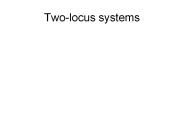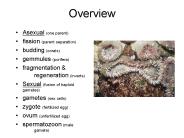Gamete PowerPoint PPT Presentations
All Time
Recommended
... ab produces these gametes in these frequencies ... of of gamete frequencies when r ... The frequency of gametes produced by generation 0, when the recombination ...
| free to view
B. methanogens. C. mycoplasmas. D. myxospores. E. purple bacteria. _____5. Fusion of cell parts other than the nucleus is called: A. fertilization. B ...
| free to download
Meiosis Gamete Production Timothy G. Standish, Ph. D.
| free to download
cl dy bl dy bl dumpy, black 200. cl dy bl cl dy bl claret, dumpy ... tot 489 511 1000. exp. Actual distance. Calculated distance. RF = 0.5. 1 2 3 4 5. Marker ...
| free to view
Title: Foundations of Biology Subject: Chromosomal Basis of Inheritance Author: T. G. Standish Last modified by: wmc user Created Date: 8/30/1956 11:14:58 AM
| free to view
Meiosis- gamete formation Mader Chapter 17.3 Mitosis does not alter the chromosomal makeup of cells Meiosis separates homologous chromosomes There are 2N Possible ...
| free to download
Gamete Formation Genetics Human Gamete Formation Gametes are the sperm and egg Both haploid (n), meaning they have only one of each type of chromosome Produced ...
| free to view
Meiosis Formation of Gametes (Eggs & Sperm) Facts About Meiosis Preceded by interphase which includes chromosome replication Two meiotic divisions --- Meiosis I and ...
| free to download
Meiosis and Gamete Formation 3 Types of Cell Division 1. Binary fission-cell division in prokaryotes 2. Cell Cycle (with Mitosis)-cell division in eukaryotes to form ...
| free to view
III. Meiosis - making of sex cells (gametes) - haploid one set of chromosomes ex. Humans - 23-- has 2 groups of divisions : Meiosis I and Meiosis II.
| free to download
* Facts About Meiosis Preceded by interphase which includes chromosome replication Two meiotic divisions --- Meiosis I and Meiosis II Called reduction division ...
| free to download
Meiosis Gamete Production 2000 Timothy G. Standish Meiosis * G. Podgorski, Biology 1010 * Meiosis * G. Podgorski, Biology 1010 * Meiosis * G. Podgorski, Biology ...
| free to view
Gametes (eggs and sperms) mature in the gonads (ovary and testis) ... chick: albumin/shell. insect: chorion. Vitelline envelope = egg coat ...
| free to view
(The Production of Gametes) Introduction. Human Body Cells have 46 chromosomes (somatic cells) ... 4. Each cell is 1n. 5. Each gamete is different!! Meiosis II ...
| free to view
KEY CONCEPT Gametes have half the number of chromosomes that body cells have. You have body cells and gametes. Body cells are also called somatic cells.
| free to download
MEIOSIS: GAMETE CELL DIVISION Recall that GAMETES are the REPRODUCTIVE (SEX) cells of the body.
| free to download
9:3:3:1 a classic phenotypic ratio when two heterozygotes at two genes are mated ... One gene, heterozygous parents (Rr): The classic 3:1 phenotypic ratio ...
| free to view
Alleles segregate during gamete formation, but do they do it independently? Two-factor Cross, F1 RRYY x rryy Round/yellow peas wrinkled ...
| free to download
D Computation in Our Hypothetical Gametic Frequency Matrix #1 ... The Fate of D. We can express P11(1) as a function of P11(0), r, and allele frequencies: ...
| free to view
Title: PowerPoint Presentation Author: McDougal Littell Last modified by: Stack, Lisa Created Date: 9/14/2006 4:17:10 PM Document presentation format
| free to view
Ins mination des spermatozo des associ s au liquide s minal (pH acide) : 200 ... Pavillon (Ostium abdominal) : franges tubaires. STRUCTURE DE LA TROMPE ...
| free to download
... (37) have come to Dr. Garcia for in vitro fertilization (IVF) using Mara's eggs and Tony's sperm. Following the first egg retrieval, eight embryos are created.
| free to view
Link Equine Reproductive Biology Program. Testicular Function / Gametes ... Grayson-Jockey Club Research Foundation. American Quarter Horse Association ...
| free to view
Chapter 38: Angiosperm Reproduction and Biotechnology Section 1: Pollination enables gametes to come together within a flower
| free to download
KEY CONCEPT Gametes have half the number of chromosomes that body cells have. You have body cells and gametes. Body cells are also called somatic cells.
| free to download
Just as in mitosis, meiosis begins with a diploid cell. ... Paternal chromosome 1. Maternal chromosome 2. Paternal chromosome 2. Meiosis ...
| free to view
... gametes are haploid. ... Meiosis makes haploid cells from diploid cells. Meiosis ... Meiosis results in haploid cells; mitosis results in diploid cells. ...
| free to view
At puberty stimulates the growth of axillary, pubic, facial and chest hair. ... Stimulate the growth of Pubic and Axillary Hair. ...
| free to download
... Profile Married/Nuclear Family some SMCs 30s-early 50s Fertility Problems often age-related unsuccessful with IUI/IVF treatments Very much want children OR ...
| free to view
I've faced that I'm not going to have this picket-fence-y life...now I have ... But something in that expression spoke to me. DE Mother of two children ...
| free to view
Patrick is heterozygous for his pink body color but is purebred dominant for having large eyes. ... Now, lets figure out the possible gamete combinations. P p R R ...
| free to view
... B allele (genotypes: BB and BO) type AB blood both alleles ... pedigree graphical representation of a family tree. pattern of inheritance in humans ...
| free to view
Let x and y be the gamete sizes of female and male ... The origin and evolution of gamete dimorphism and the male-female phenomenon. ...
| free to view
... cell mitosis occurs in the pollen tube 8-12 h after germination, resulting in ... Concomitant with pollen tube arrival, egg cells increase in DNA quantity from 1C ...
| free to view
17% rise in babies born to 30-44 unmarried women between 1999-2003 ... Surrogate Mothers. Gestational Surrogates. Research Methods. Participant Observation ...
| free to view
Cell divides into two copies of itself, one of which is the same size as the ... occur in the body of the water as plankton or on the bottom where they may be ...
| free to view
Sex Determination in Humans XX-XY sex determination Presence of a gene on the Y chromosome determines maleness Which arise when the sex chromosomes do not ...
| free to view
Meiosis Notes Cell division to form the gametes, sperm (male gamete) and egg (female gamete). Normal cells are diploid: 2 copies of every gene. Gametes are haploid: 1 ...
| free to view
Sexual Reproduction 2 parents produce offspring that inherit traits from both parents Each Parent produces gametes Female gamete Male gamete The Female gamete and ...
| free to view
Ch.11.4 - Meiosis Formation of Gametes (egg & sperm)
| free to download
i) a gamete (2n) fused with a normal gamete (n) ii) chromosomes disable to ... iii) gamete from tetraploid organism (4n) fused with diploid organism gamete (2n) ...
| free to view
GAMETE CELL DIVISION (In Humans): Meiosis: Anaphase II: GAMETE CELL DIVISION (In Humans): Meiosis: Telophase II: 1. Nuclear membranes reappear.
| free to download
phenotype ?????????????????????? ????????????????? gametes ??????? parental type ... ??????? gamete ??????? double crossing over ?????????? gamete ??????? parental ...
| free to view
... gamete formation the paired unit factors segregate randomly so that each gamete ... of Independent Assortment During gamete formation, segregating pairs of unit ...
| free to view
Meiosis Notes Gamete (Sex Cell) Formation In female animals (including humans), the haploid gametes produced by meiosis are called eggs The cell divisions at the end ...
| free to view
Two-locus systems Scheme of genotypes Two-locus two allele population Table gametes from genotypes I Table gametes from genotypes II Table zygote productions Two ...
| free to download
Sexual (fusion of haploid gametes) gametes (sex cells) zygote (fertilized egg) ... spermatozoon (male gamete) Animal Reproduction & Development (Chapter 46 & 47) ...
| free to download
They have both male and female sex cells called gametes. ... and female gametes come together. This is when the pollen grain bonds with the female gamete in the ...
| free to view
Lesson 9.3: Meiosis: The Life Cycle of Sex Cells Goals: Identify male and female gametes Compare chromosome numbers between somatic cells and gametes
| free to download
Site of male gamete formation= spermatogenesis. Produces testosterone. Testes (testis sing. ... has 4 chromosomes = 2N and creates 4 different possible gametes. ...
| free to view
... split up, with one chromosome going to one gamete and the other to the other. ... Four possible combinations in gametes (egg or sperm) ...
| free to download
Chromosomes are duplicated in germ cells. Germ cells undergo meiosis and ... Cellular descendents of germ cells become gametes. Gametes meet at fertilization ...
| free to view
gamete concentrations. fertilization efficiency (avg. # sperm to fertilize an egg) ... even at high gamete concentrations. ... e. allow for dilution of gametes. ...
| free to download
fertilization of female gametangium by male gamete. 3. somatogamy ... fertilization of an ascogonium by a male gamete. no antheridium involved ...
| free to view
Unbalanced gamete production *Ramsey & Schemske, 2002. Ancient vs. Neopolyploidy ... What is interesting about ancient polyploidy? ...
| free to download
























































